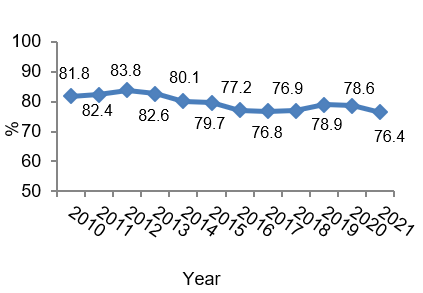The Palestinian Central Bureau of Statistics (PCBS), and the Palestinian Water Authority (PWA) Issue a joint Press Release on the World Water Day; on March 22nd, 2023
Under the theme of "ACCELERATING CHANGE", the World celebrates the World Water Day, 2023.
The Palestinian Central Bureau of Statistics (PCBS) and the Palestinian Water Authority (PWA) issue a joint press release on the World Water Day, on March 22nd, 2023. This year, the World Water Day is celebrated under the theme of "Accelerating Change" to solve the water and sanitation crisis, because water affects us all, and we need everyone to take action, according to the announcement of the United Nations – Water.
76% of Available Water is from Groundwater
Data showed that the percentage of abstracted surface and groundwater from available water during 2021 was high with an average of 76.4%.
On the other hand, the quantity of water pumped from the Palestinian wells in the West Bank in 2021 was 105.3 MCM from Eastern Aquifer, Western Aquifer and North-Eastern Aquifer.
It should be noted that Palestinians have been denied, by the Israeli occupation, to access and abstract water from the Jordan River since 1967, which is estimated of about 250 MCM.
Percentage of abstracted surface and groundwater from available water, 2010-2021

22% of the Available Water in Palestine is purchased from the Israeli Water Company "Mekorot"
With scarce water and Israeli restrictions on access to resources, Palestinians are forced to purchase water from the Israeli water company “Mekorot”. In 2021, they purchased 96.1 MCM, which represented 22% of the water available in Palestine (438.4 MCM). Additionally, 37 MCM of the water were produced from the Palestinian springs while 297.8 MCM are pumped from groundwater wells and 7.5 MCM desalinated drinking water, representing 1.7% of the available water.
As for water available to Palestinians that is unsuitable for human use due to the quantities of polluted water in Gaza Strip, it reached 186.7 MCM, whereas the quantities of water suitable for domestic use available to the Palestinians are only 251.7 MCM, including purchased and desalinated water.
7.5 MCM desalinated drinking water
The amount of desalinated drinking water in Gaza Strip was only 7.5 million m3 in 2021. Moreover and according to the data of the Palestinian Water Authority, Palestine began producing quantities of desalinated water, where the percentage of which is expected to increase in the coming years; with the start of operating desalination plants in Gaza Strip. Thus, this percentage shall rise significantly with the implementation of the central desalination plant program.
Selected Indicators for Water Statistics in Palestine, 2019-2021
Quantity in Million m3/Year
|
Indicator |
2019 |
2020 |
2021 |
|
Quantity of Water Available Annually |
417.9 |
448.4 |
438.4 |
|
Quantity Pumped Annually from Groundwater Wells |
289.0 |
299.1 |
297.8 |
|
Quantity of Spring Water Discharged Annually |
40.6 |
53.3 |
37.0 |
|
Quantity of Water Purchased Annually from Israeli Water Company (Mekorot) for Domestic Use |
84.2 |
90.3 |
96.1 |
|
Desalinated Drinking Water |
4.1 |
5.7 |
7.5 |
|
Quantity of Annual Water Supply for Domestic Sector |
227.3 |
232.6 |
250.7 |
*Data excluded those parts of Jerusalem which were annexed by Israeli occupation in 1967.
More than 97% of the water pumped from the Coastal Aquifer does not meet the standards of the World Health Organization
The amount of water abstracted from the coastal aquifer was 192.5 million cubic meters (MCM) in Gaza Strip in 2021. However, this quantity is obtained via unsafe pumping that jeopardizes the sustainability of the source, as the basin sustainable yield should not exceed 50-60 MCM a year, where the groundwater level in the coastal aquifer reached 19 meters below sea level leading to the depletion of groundwater reserves, this led 97% of the water pumped from the coastal aquifer in Gaza Strip does not meet the water quality standards of the World Health Organization.
The daily allocation per capita from consumed water is less than the internationally recommended rate, and it is decreasing
The daily allocation per capita from consumed water for domestic purposes is 86.3 liter/capita/day in Palestine: 89.0 (l/c/d) in the West Bank, while it is 82.7 (l/c/d) in Gaza Strip in 2021. By taking into account the increase of population, the high percentage of water pollution in Gaza Strip and calculating the quantities of water suitable for human use from the available quantities, the per capita share of fresh water is only 21.3 liters per day in Gaza Stip. When comparing this rate with the Israeli daily allocation per capita, we note that the Israeli daily allocation per capita is more than three times that of the Palestinian individual, about 300 liters per day, and this rate doubles for Israeli settlers to more than 7 times than Palestinian per capita consumption.
Taking into account the discrepancy of the daily allocation of consumed water per capita between the different governorates, achieving justice in the distribution among localities is one of the main challenges facing the State of Palestine due to the political situation it lives in that hinders the development of an integrated water system at the national level. It is worth noting that the average Palestinian water consumption per capita is still less than the minimum recommended level globally according to the standards of the World Health Organization, which is 100 liters per day. This is as a result of the Israeli control over more than 85% of the Palestinian water.
Note: Data mentioned in this press release excludes those parts of Jerusalem which were annexed by Israeli occupation in 1967.
*Sources:
Palestinian Central Bureau of Statistics. 2022. Water Tables in Palestine 2021. Ramallah - Palestine.
Palestinian Water Authority, 2021. Water Information System. Water Information System. Ramallah - Palestine.
 عربي
عربي